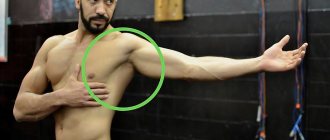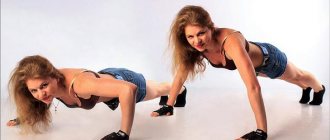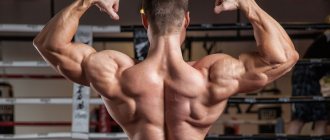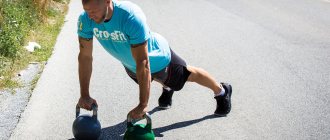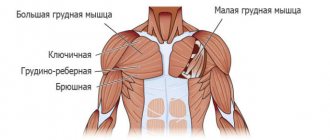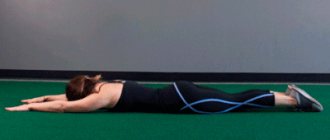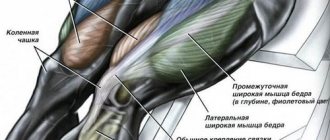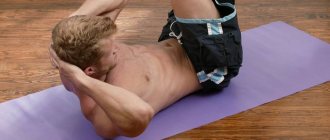Adjustable bench
This device will help you train comfortably, change the angles of loads (this is very important for the pectoral muscles) + you can train many other muscle groups (the same abs, all kinds of presses, push-ups on a bench, doing dumbbell rows with an emphasis on the bench) in Overall, I recommend this device...
That's all, friends.
All you need is:
- collapsible dumbbells (weighing from 10 to 40 kg)
- parallel bars (ideally a wall bars with a horizontal bar)
- adjustable bench
The most important thing is, of course, collapsible dumbbells. Because We don’t have the opportunity to purchase an Olympic bar and weights for it, for many reasons (no money, no space, or some other reason) we need an alternative and these are dumbbells!

Presses
The difference between this exercise is the presence of a horizontal bench, barbell or dumbbells. During exercise, tension is relieved from the back.
By changing the inclination of the bench, you can pump the upper or lower pectoral muscles.
This exercise is basic and most popular, as it helps develop the athlete’s figure into a reverse triangle shape.
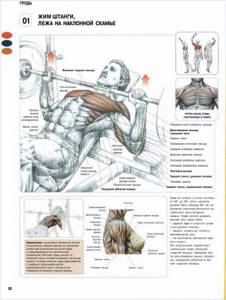
Examples of programs for training chest muscles
Before I describe the complex to you, I’ll tell you about the basic rules that I took into account when writing programs:
- The order of the exercises is as follows: we start with the more complex (heavy) and end with the simpler (lighter). See below what should be the first exercise.
- The first exercise for training at home will be one of two possible: dumbbell bench presses or parallel bars.
- If you don't have parallel bars and have heavy dumbbells, start with dumbbell bench presses.
- If you don't have heavy dumbbells, start your workout with parallel bars.
- Perform about 4-6 working sets of 6-12 repetitions. But before working, do not forget to do warm-ups with light weights for 10-20 repetitions.
- Select weights (dumbbell weights) so that muscle failure occurs within 6-12 repetitions. If you were able to do more than 12 times, the weight is small for you, you should increase the weight of the dumbbells (otherwise there will be no growth).
Training programs
- Dumbbell bench press 4-6x6-12 reps
- Dips 4-6x6-12 reps
- Lying dumbbell fly 4x6-12 reps
Either way
- Dips 4-6x6-12 reps
- Dumbbell bench press 4-6x6-12 reps
- Lying dumbbell fly 4x6-12 reps
Either way
- Dips 6x6-12
- Dumbbell bench press 8x6-12
Either way
- Dumbbell bench press 6x6-12
- Push-ups from the floor (with additional weights) 5-6x6-15
- Lying dumbbell fly 4-6x6-12
This is a very important parameter that I must explain to you - the technique of performing the exercises.
Those. For a full training of the pectoral muscles, it is vitally important to follow the correct technique, otherwise there can be no talk of any growth of the pectoral muscles.
Let me explain! You can do push-ups (but with an emphasis not on the chest, but on the triceps); accordingly, your arms grow, but your chest does not. The same goes for dumbbell bench presses. Technology is extremely important...
How to pump your pectoral muscles correctly
Remember, there are only three real reasons why the majority of trainees do not have impressive pecs:
- Firstly , the athlete cannot qualitatively feel the work of muscle fibers when performing a chest exercise. The result is a poor neuromuscular connection; the brain cannot 100% engage the pectoral muscles and cause microtrauma to the muscle fibers.
- Secondly , how can we talk about growth and overcompensation when there is no increase in training weights and the body does not receive stress, which is the main reason for the growth of muscle fibers.
- Thirdly , most athletes incorrectly emphasize the load, always training only certain areas of the pectoral muscles.
Watch a master class on training the pectoral muscles
For the rest of the reasons, just forget, they are not justified and were invented by theorists of glossy magazines to force you to buy another newfangled supplement that will definitely take the development of your muscles to a new level.
Surely you have a question, what about the technical nuances of performing the exercise, because this plays an important role in the development of a certain muscle structure. The answer to this question lies in the first point, which is not in vain in the initial position. Why do you need technique when performing an exercise in order to efficiently load muscle fibers? However, if there is no neuromuscular connection, no technical tricks will make your pectoral muscles grow.
The correct technique is necessary so that the brain can select the optimal range of motion and efficiently contract the training muscle. By using proper technique, you make it easier on your brain and give it the ability to optimally push your muscles to the point of failure. Naturally, the consequence of such an attitude to training is an increase in muscle mass and strength.
Therefore, exercise technique and the ability to correctly contract muscle fibers are concepts that cannot exist separately. What conclusion can we draw from all of the above:
- correct technical skills with poor neuromuscular connection will not help you qualitatively reduce the working muscle group;
- a good neuromuscular connection, even with satisfactory exercise technique, will push your muscles to failure and trigger the mechanism of overcompensation and growth.
Without understanding the points described above, there is simply no point in describing instructions for enlarging the pectoral muscles. Because athletes will apply new recommendations without correcting simple fundamental errors that will not make it possible to increase muscle size.
How to solve the above problems that inhibit the growth of the pectoral muscles of 90% of training athletes?
- All exercises aimed at developing the pectoral muscles should be performed with ideal technique.
- Daily visualization before bed.
You need to conduct daily training of the neuromuscular system. Before going to bed, perform an imaginary exercise without additional weights for 5 minutes. This is necessary to learn how to properly engage muscles. At the same time, the effect is stunning; your brain will learn to highly effectively contract the muscle group at the time of the exercise.
Lack of progression in training loads!
There is a well-known and undeniable axiom of iron sports; in order to start the growth mechanism, it is necessary to systematically increase training weights. This is exactly what 90% of athletes cannot understand and put into practice. The majority make an ambiguous increase in the bench press and then train with this weight throughout the year. Naturally, there can be no talk of growth.
You can ignore all the other rules and still increase muscle mass by adding 1 kilogram per month on the bench press. Believe me, you will grow, even if the technical aspect is bad.
You can change the intensity of training using different methods: increasing the weight of the apparatus, reducing rest between sets, increasing or decreasing the number of approaches and repetitions. But until you bench press 140–150 kilograms, the main anabolic steroid for you is considered to be cyclical weight gain.
Dips
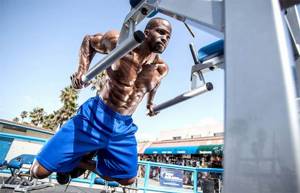
This is a heavy compound exercise that will help your pectoral muscles grow.
Subject to the correct execution technique and progression of loads.
You will need to constantly increase the load (increase the weights or repetitions), for example, you did 12 times with your own weight, add weight on yourself +1 kg, did 8 times, the next workout again with the same +1 kilograms, do 10 or 11 (as many as you get) as soon as reach 12 repetitions, INCREASE THE WEIGHT (BUT NOT MUCH by 1.25 or 2.25 kg NO MORE). In a month it will already be 10 kg, in 2 - 15. This is the progression of the load. Okay, I’ve moved away, let’s look at the equipment.
In order to include only the chest in the work and at the same time completely turn off the triceps, you need to spread your arms as wide as possible when doing push-ups, the next thing you need to do is not to straighten your arms all the way at the top point (i.e. go down and rise up but not all the way, DO NOT BEND YOUR ARMS). Only with this execution will the load be maintained in the chest. The next thing you need to do is tilt your body forward. Those. remember, the more you tilt your body forward, the more your pecs will work; the more you tilt your body back, the more your triceps will work.
Conclusion: Weigh on the uneven bars, arms as wide as possible, bend forward as much as possible, start doing push-ups and do not straighten your arms at the top point, and so on for 12 repetitions. Breathing: exhale with effort, that is, when you reach the top point, exhale (exhale air).
Exercises on simulators
Depending on the goal being pursued, you can exercise in the gym according to three programs:
- To ground;
- On strength;
- On the relief.
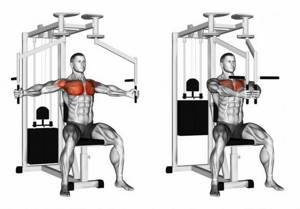
The last point can be ignored, since it is needed only for professional athletes with extensive training experience and developed muscles.
They perform it before competitions, or to give their body an aesthetic appearance. To do this, they pump the inner part of the pectoral muscles or other lagging areas.

Strength and mass training vary in the weight used.
An athlete who wants to develop strength must work with an apparatus that can lift a maximum of 5 times. This contributes to maximum damage to muscle tissue fibers, which, when restored, become stronger and larger.

At the same time, the increased load on the nervous system helps to thicken the fatty protection of neurons, thereby increasing maximum force.
The great advantage of strength training is the comprehensive development of the whole body. There is a gain in mass and strengthening of the tendons.
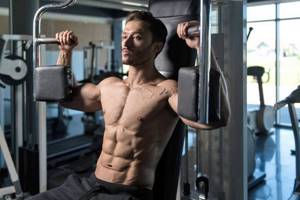
Mass training is designed to only damage the maximum number of muscle fibers in all muscles. Lighter weights are used for this.
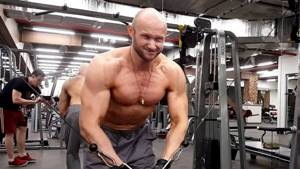
Standard lifts are those that the athlete can lift 8-12 times.
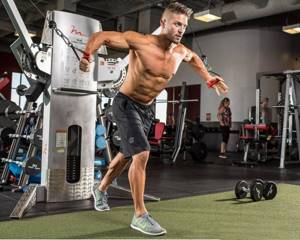
Thanks to this, failure of a certain group does not occur longer, which allows for better development of auxiliary areas.
Basic exercises for pumping up the chest
Basic exercises with a barbell for the pectoral muscles involve pressing on a horizontal and inclined bench. Horizontal presses increase muscle strength, stimulating their growth, and inclined presses allow you to work the entire volume of muscle fibers.
Advice! To pump up the upper chest, you need to use a bench with a positive incline within 20-30 degrees. In this case, it is necessary to use the bench press with a narrow grip. To clearly define the lower chest, use a bench press that has a slight negative slope.

Correct execution of bench presses
The entire set of exercises with a barbell for the pectoral muscles should include 5-6 sets of horizontal and 4 sets of inclined presses. To effectively increase muscle strength, 6 repetitions is optimal.
Bench press on a horizontal bench
This exercise is basic for the chest muscles and affects the entire upper body. This press will allow you to pump not only the entire area of the pectoral muscles, but also the triceps, the anterior heads of the deltoid muscles, and also the back muscles.
In order to perform the exercise correctly, you must follow the following rules:
- Position yourself on a horizontal bench so that the bar is in front of your eyes.
- Your back should be slightly arched so that your pelvis does not open away from the bench.
- The grip should match the width of your shoulders. The legs are in support.
- Now remove the barbell from the racks and slowly, while inhaling, lower it to the center of the pectoral muscles.
Advice! When lowering the bar, try not to flare your elbows out to the sides to fully engage your pectoral muscles.
- As you exhale, return to the starting position.
This exercise should be performed with full amplitude so that your head does not leave the bench.
Advice! It is recommended to perform this exercise in a pyramid, when, by reducing the number of repetitions, you increase the working weight.
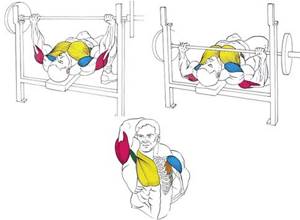
Muscles used in the basic bench press
You can perform bench presses on a horizontal bench with different grip widths. With a wide grip, the load on the triceps decreases, and the load on the outer area of the pectoral muscles increases. A narrow grip, on the other hand, places the load on the inner parts of the pectoral muscles. Lowering the barbell closer to your neck will provide a better stretch for your pectoral muscles.
Close grip bench press
The close grip pectoral press has approximately the same effect on the pecs, triceps, and deltoids.
To perform the exercise correctly, follow these recommendations:
- Lie down on a bench, grasping the bar with an overhand grip with a distance between your hands of 15–20 cm.
- After removing the bar from the racks, straighten your arms up so that your shoulder joints are under the bar.

Close grip bench press
- Now slowly lower the barbell until the bar touches your upper chest.
Important! At the bottom, your elbows should be at a 45-degree angle to your body.
Variations for performing this exercise include the incline bench press and the use of different grip widths.
Incline Bench Press
A strong impact on the upper part of the pectoral muscles occurs due to the bench, which is installed at an angle of 45 degrees. Also, the exercise has a secondary effect on the triceps and deltoid muscles.
The incline bench press should be performed in several stages:
- Take your starting position on the bench.

Correct execution of the incline bench press
- Grasp the barbell with an overhand grip, then remove the barbell from the racks.
- Lower your hands to the level of your collarbone.
- Return to the starting position.
Advice! When performing this exercise, you need to spread your elbows to the sides.
Various inclinations of the bench are also possible here. For example, with an inclination of 30 degrees, the load on the pectoral muscles increases, and on the delta, on the contrary, decreases.
Head down incline press
This exercise targets the outer and lower parts of the pectoral muscles. To implement it, you must adhere to the following recommendations:
- Lie on an incline bench set at an angle of 15-30 degrees, head down.
- Grasp the barbell with an overhand grip, then remove it from the racks.
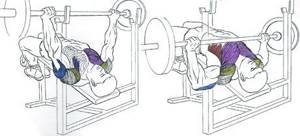
Reverse Incline Bench Press
- Raise the barbell up until your arms are perpendicular to the floor.
- Lower the barbell to the level of the middle of the pectoral muscles.
- After the bar touches your chest, lift it along the same path.
The video shows what exercises you need to do to pump up your chest with a barbell.
Important! You should not overuse this exercise, otherwise your breasts may become saggy.
This material will be perfectly complemented by the following publications:
- Chest training program: split programs from professionals
- Exercises to pump the upper pectoral muscles
